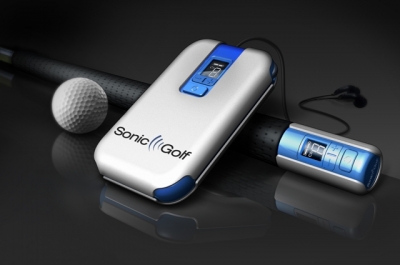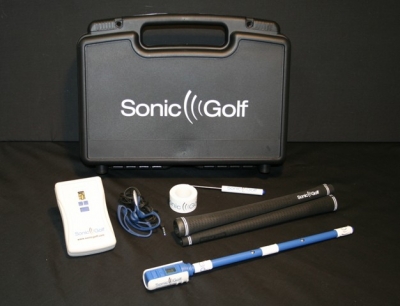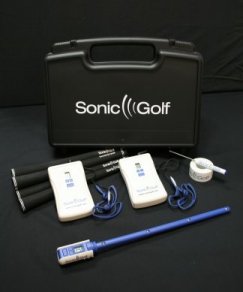By Jeffrey A. Rendall, Images courtesy of Sonic Golf
BETHANY, CT -- “Tempo is everything, perfection unobtainable,” mused ‘Tin Cup’ Roy McAvoy as part of his ‘golf poem’ driving range lesson in trying to describe the golf swing to a beginning golf student.
Truer words were never spoken, and though I’m not sure McAvoy could teach anyone the real meaning of golf (or of life), he certainly hit the nail on the head when it comes to the most underrated aspect of teaching the golf swing – tempo.
That’s where a new swing-aid enters the picture, a device introduced by Sonic Golf that allows you to literally ‘hear’ your golf swing, commit it to memory, and play it back over and over again to improve your consistency on the golf course. Many swing aids claim to have the answer to many different ‘flaws,’ but this is one of the few that addresses a purely mental side of the game that is so hard to pin down.
Sonic’s Golf System-1 was invented by Yale University physicist Dr. Robert Grober to help players get a better sense of their golf swing’s flowing movement – and it’s useful for all levels of players from first-time beginners all the way to the best players in the world. Vijay Singh used the Sonic system to groove his swing last year, which ultimately resulted in his winning the FedEx Cup in 2008.
Simply put, using the Sonic system improves your tempo, rhythm and timing – as if you thought all of those were one and the same.
 |
Grober uses his teaching background to explain why, as McAvoy said above, ‘tempo is everything’: “Tempo, rhythm and timing are the glue that holds the whole golf swing together. ‘Conventional’ golf instruction has focused on swing mechanics for decades, with even greater emphasis on mechanics in our modern age of video playback and single-frame analysis.”
“Mechanics are certainly important in the golf swing, but you can’t get by on mechanics alone. Even if your swing is mechanically sound, you won’t really be at your best unless you have great tempo, rhythm and timing to go along with it,” Grober added.
After all, every great Tour player has had great tempo, from the amazingly fluid motion of Sam Snead to the controlled violence of Arnold Palmer to the sweet syrupy movement of Ernie Els – all of them different, but with one thing in common – a consistent tempo, fit perfectly for their own golf swings.
Grober continues, “Tempo, rhythm and timing help put a player’s swing mechanics to work in a way that’s dynamic and efficient. We’ve found that faulty swing mechanics tend to fix themselves when tempo, rhythm and timing improve. Sonic Golf trains tempo, rhythm and timing in a new way, drastically improving the way we learn, play and teach the golf swing.”
Leave it to a physicist to bring ‘dynamics’ into the game of golf, which clearly brings you back to the old days of high school physics – but unlike those hours of mundane lectures, the ‘dynamics’ that Grober is talking about will produce real results on the golf course, where it counts.
Grober says when it comes to golf, it’s useful to think of tempo, rhythm and timing as different concepts.
 |
“In music, the tempo could be “allegro,” for example, but the rhythm could be Latin or Western, Swing or Hip Hop,” Grober explained. “Tempo is a measure of time, but rhythm is what the musicians and dancers do in the sound space in between the beats per minute of tempo that makes the sound unique.”
Okay, but how do these musical concepts apply to your time on the practice tee?
Again, Grober has the answers. “Tempo is the duration of the backswing and the duration of the downswing. All the best players have very similar tempo, as hard as it is to believe. It takes them almost the same amount of time from the start of their swings to actually striking the ball – and the ratio of time between the backswing and downswing is very close for nearly all professionals, between 2.5 and 3.5 to 1.”
In other words, the best of the best have discovered the ‘tempo’ formula for success. It’s true, everyone is different, but if you examine professionals as a group, they all look very similar at point of impact – and now it turns out that they’re comparable in tempo as well.
They don’t swing ‘hard’ or ‘soft,’ ‘fast’ or ‘slow’ – they swing consistently. And it’s unique to each one of them.
“Timing could be described as the order and synchronization of the body parts throughout the swing – the points at which the feet, the hips, the shoulders, the arms and the hands move and release. It takes proper timing, or sequencing, to apply maximum force at the ball with the club head square and moving properly down the target line,” Grober lectured.
 |
“Good tempo, rhythmically applied with proper timing equals a great golf shot. Even Tour professionals have different grips, stances, ball positions, etc. But they all have in common great tempo, rhythm, and timing,” Grober added.
Now that we’re sold on the ideas of good tempo, rhythm and timing, Grober’s Sonic Golf System-1 is there to help us get it. And again, unlike other swing aids, the assistance is much more mental than physical.
The Sonic system begins with inserting an electronic transmitter into the shaft of your golf club, which transmits your swing motion wirelessly to a receiver that can be worn on your belt. The receiver turns the motions into sounds, and you listen to them through a Sony headset that also comes with the system.
It sounds complicated, but it’s really not. If you can operate an Ipod (and can hear) -- you can use this system. What does it sound like? Slow swings are low pitch, quiet tones. Swing faster, and the pitch volume gets higher. And don’t worry, you’ll definitely ‘hear’ the difference.
The device will tell you when your backswing ends and your downswing begins, when you’re achieving maximum speed, the total duration of your swing, and even how you follow-through. Once you’ve ‘grooved’ the sound to a point where the tempo is right, you can work at different elements of the swing – and most importantly, be consistent.
The Sonic system is so useful that legendary golf instructor Hank Haney has employed it to try and ‘fix’ Charles Barkley’s hopeless swing on the Golf Channel series ‘The Haney Project.’ Haney’s pulling out all the stops to try and get Barkley to put some tempo into his swing – and the Sonic device is perfect to do just that.
 |
| System-1 Pro Edition |
Perhaps most importantly, the Sonic system can be used with your own golf clubs. The System-1 Solo edition comes complete with a transmitter/shaft insert, a receiver, three Golf Pride specialty grips (specially made to accommodate the shaft insert), a stereo headphone system – and the extras needed to properly install the system, and learn how to use it.
The Pro-edition ships with more grips and two transmitters, two receivers and the necessary components so that both instructor and student can listen at the same time.
The Sonic system isn’t inexpensive – it costs about as much as a new high-end driver – but in the end, it will likely save you more strokes and more aggravation than some other golf products that ultimately won’t change the most flawed part of your golf swing – you.
Grober gets the last word: “With the Sonic Golf System-1, you can hear good tempo in your swing. You can hear if you’re ‘casting from the top’ and releasing early and correct it by ‘moving the sound forward’ in your swing. By the same token, you can also hear if you’re making a nice, smooth transition at the top, with the club moving quietly around your body.”
The Sonic system is a completely new and different way to ‘think’ about your golf swing, and you’ll know it when you ‘hear’ it – and hearing truly is believing.
Details:
41 Village Lane, Suites 104 & 105
Bethany, CT 06524
Phone: (203) 764-2046
Website: http://sonicgolf.com/
Email: info@sonicgolf.com
| Related Links | Comments on this article? | |
|
Maryland National Golf Club Hollow Creek Golf Club Rocky Gap Resort PB Dye Golf Club in Ijamsville Whiskey Creek Golf Club |
E-mail Jeff Rendall, Editor: jrendall@golftheunitedstates.com |











